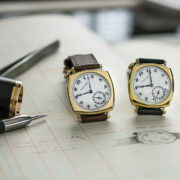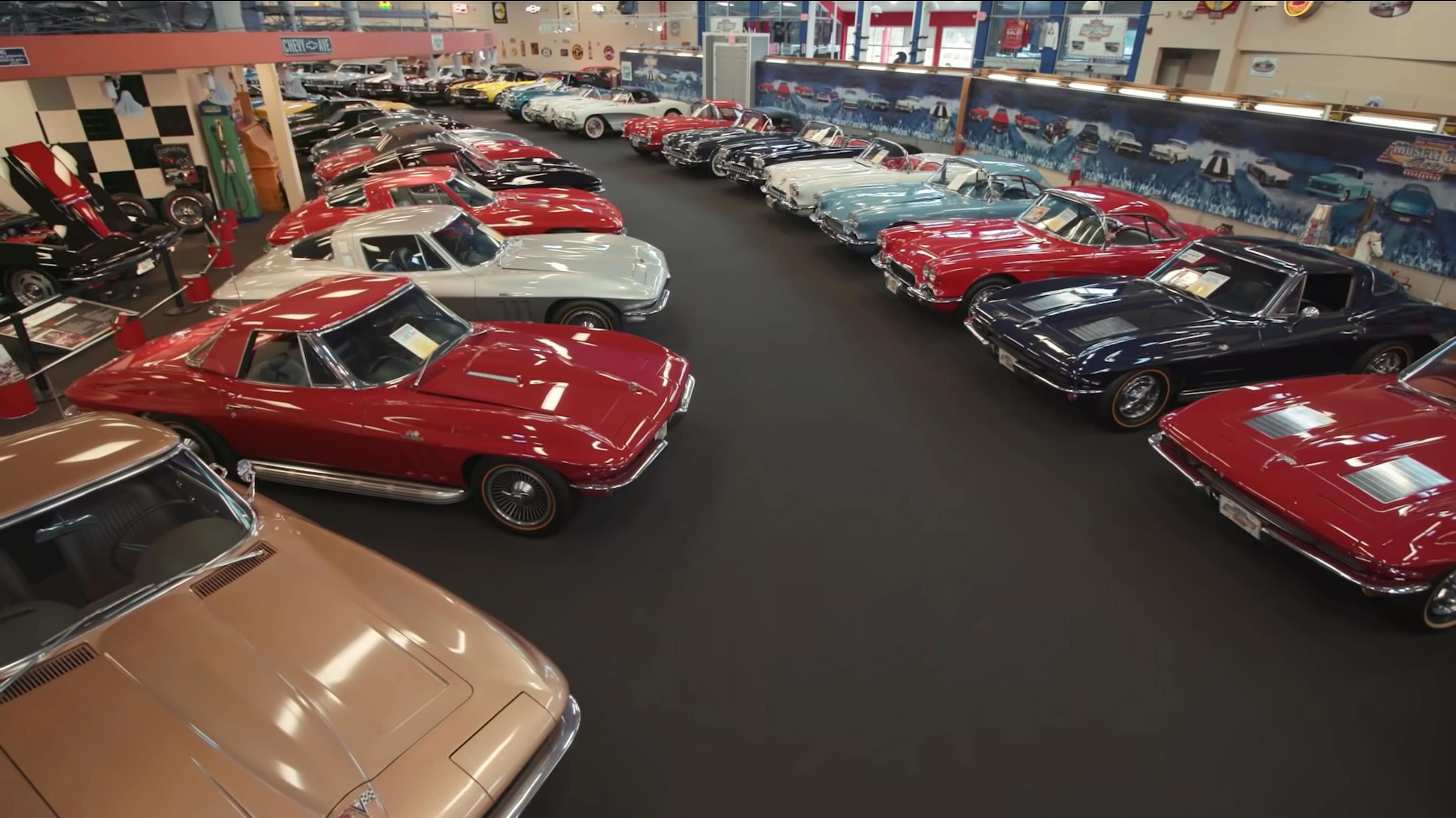Vacheron Constantin | American 1921 Pièce unique: The iconic American 1921 watch faithfully recreated as if in 1921
- To celebrate the 100th anniversary of the American 1921, Vacheron Constantin has faithfully created this emblematic model from the Roaring Twenties while safeguarding its original attributes.
- This exceptional one-of-a-kind creation symbolises the Manufacture’s commitment to the transmission and enhancement of traditional skills.
Geneva, May 25th 2021 – To mark the 100th anniversary of the American 1921 watch, Vacheron Constantin has delved into its archives and its horological expertise to offer a faithful reproduction of the timepiece emblematic of an era. Stemming from an impressive technical and human epic saga pushing the limits of fine craftsmanship excellence, the creation of the American 1921 Pièce unique watch mobilised the remarkable expertises of the Maison’s Restoration workshop and the Heritage department for an entire year. This approach might be a first in the watch industry, reflecting Vacheron Constantin’s commitment to the conservation, transmission and continuous enrichment of its heritage and of traditional skills.
Only 24 pieces of the reference dated 1921 were originally manufactured. Today only one of them is part of Vacheron Constantin’s private collection, making it an extremely rare and sought-after timepiece for collectors and watch connoisseurs. Some watches tell stories, inviting us to travel back in time, to retrace origins and immerse oneself in bygone eras. Faithfully recreated as if in 1921, the American 1921 Pièce unique watch presented this year is a case in point, offering a journey into the creativity of the Roaring Twenties and reviving the beauty of artisanal skills as practiced a century ago. More than a jubilee watch, it is the fruit of a fascinating odyssey into the heart of the artisanal know-how cultivated by Vacheron Constantin for over 265 years.
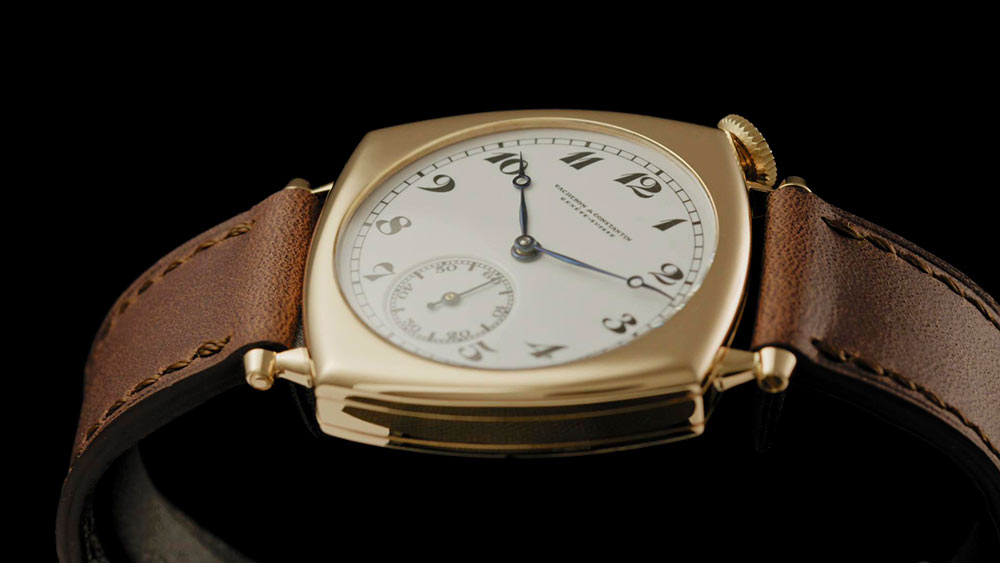
American 1921 Pièce unique: The iconic American 1921 watch faithfully recreated as if in 1921
Heritage and Restoration departments’ commitment to perpetuate the art of high watchmaking
When the idea of faithfully recreating an American 1921 model from the Vacheron Constantin private collection first took shape, the project looked set to be both exciting and ambitious.
A bridge between the past and future of the Maison, the Vacheron Constantin Heritage department has a place of its own within the Manufacture. Spanning an exceptional timeline that began in 1755, and overseeing a unique collection, it is anything but a dusty museum. The research and expertise of the teams working there on a daily basis are an inexhaustible source of inspiration for the creation of new collections and a masterful reference for the Restoration workshop. The department preserves 800 machine tools, workbenches and sets of watchmaking tools, along with substantial documentary and iconographic archives. No less than 420 linear metres are taken up by an infinite wealth of production and accounting registers comprising foreign sales, correspondence between associates, suppliers and clients, various documents and photographs. All contribute to shedding both historical and artistic light on Vacheron Constantin’s activity through the years and centuries. They represent a sum of written instruments serving to ensure the traceability of a creation since its origins, given that all the models produced are systematically referenced in the production registers. This unprecedent heritage helped retrace the history of the creation of the American 1921 and provided a solid basis for the Restoration workshop teams. The latter thus took up the authentic challenge of reviving some forgotten skills and combining today’s techniques with yesterday’s know-how.
Few Manufactures are able to restore all the watches that have come out of their workshops for centuries. That is why Vacheron Constantin makes it a point of honor to pass on this watchmaking know-how and to ensure that the great history of each of its timepieces continues. The skill and style of the Restoration artisans thus consists in showing respect for ethical considerations in their work. To achieve this, they can draw upon a substantial stock of components, adjust component blanks or entirely remake them – the latter being the most delicate task of all and calling for particularly complex size calculations. Experts in the art of maintaining Vacheron Constantin’s oldest timepieces without altering their nature, the Restoration workshop’s seasoned watchmakers are thus accustomed to combining a historian’s perspective with scientific analysis, but until now they had never undertaken to reproduce an antique watch in its entirety. This unprecedented work of reconstitution, respectful of ethics because it is faithful and precise down to the smallest detail, called upon the multiple competencies of these artisans, who pursued an empirical approach throughout this year-long project.
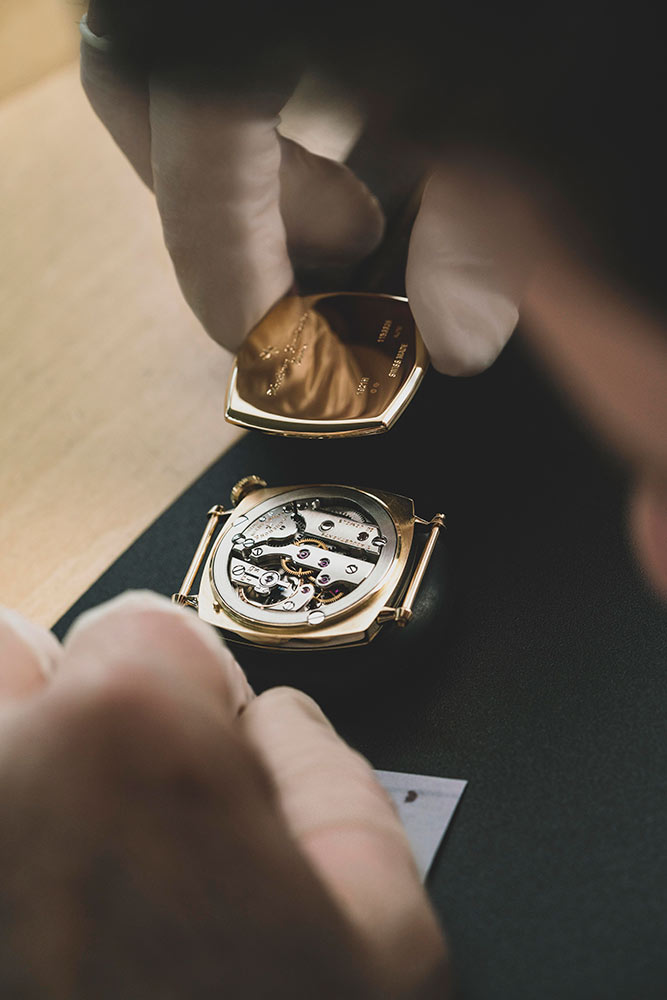
American 1921 Pièce unique: The iconic American 1921 watch faithfully recreated as if in 1921
Several months of research in the Manufacture’s archives, weeks of reflection and observation, numerous experiments, as well as unsuccessful attempts and successful trials were necessary to produce such a work. The American 1921 Pièce unique will be in the spotlight throughout 2021 through prolonged exposure in Vacheron Constantin boutiques around the world.
Antique machines and tools
In order to reproduce the hand-crafted operations performed back in the day, artisans had to work with some historical tools from Vacheron Constantin’s Heritage. A late 19th century facing lathe enabled them to faithfully recreate the elements composing the case; a rounding-up (topping) tool from the latter half of the 19th century served to modify the profile of wheel teeth and to adjust their diameter. Watchmakers used an 18th century upright drilling accessory to drill through the movement’s mainplate. To drive the jewels into their settings, they resorted to an early 20th century staking tool.
These vintage machines were complemented by tools specially made for this project, such as custom-made milling-cutters and riveting tools in line with those of the early 20th century, enabling the artisans to work in a manner attuned to that period and closely reproducing the operations and development techniques of the time. The result of this remarkable stylistic exercise is an exceptional collector’s item symbolising Vacheron Constantin’s unwavering commitment to the transmission, enhancement and continuous enrichment of its production skills.
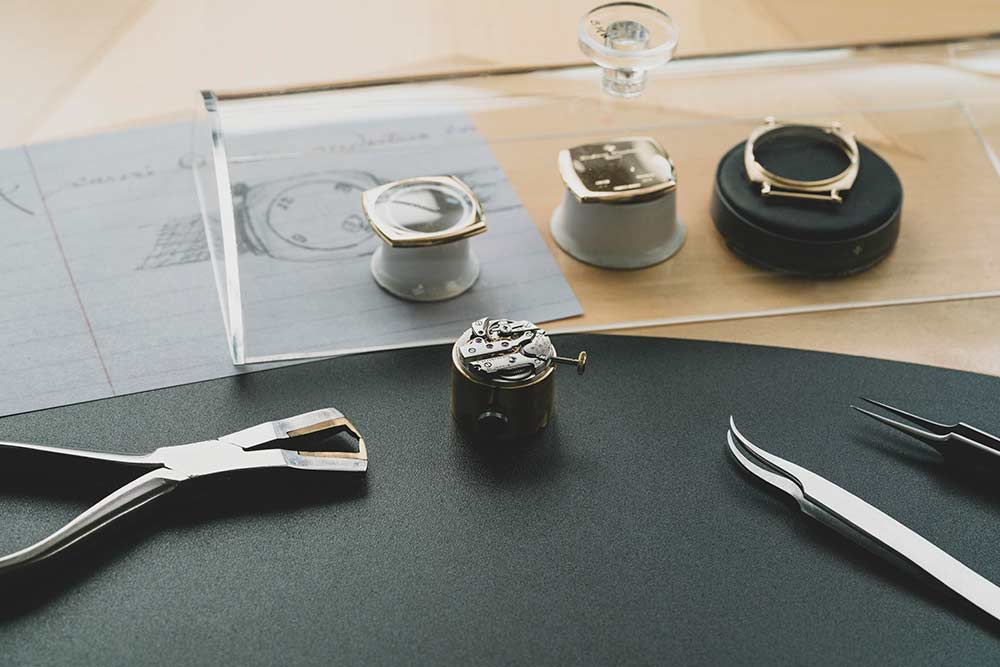
Rebirth of a vintage movement
While the watchmakers in Vacheron Constantin’s Restoration workshop fully master the art of bringing back to life the most exceptional timepieces produced by the Manufacture in the course of its long history, never before had they been called upon to rebuild a vintage calibre from scratch.
They began by disassembling and examining every single component of the original 11-ligne Calibre Nouveau powering the original model. Apart from the bridges and mainplate which had to be recreated, the Restoration workshop’s stocks proved to be a goldmine for the artisans who thereby had access to all the necessary blank parts. This involved extremely laborious research, since a vintage case could contain an infinite number of components, all different in terms of size and shape. In order to identify them one by one, the first stage consisted in taking the measurements and dimensions of each of the 115 components of the original movement. This meticulous work of observation and comparison subsequently led watchmakers to make plans and mock-ups of the calibre, a particularly delicate task requiring extremely complex sizing calculations.
At this stage, the archive documents safeguarded by the Heritage department proved extremely valuable, notably in recreating the bridges and the mainplate according to the specificities of this vintage movement. How could each component be adjusted and calibrated prior to assembly? How should the vintage machines be regulated? How could the jewels be set on the movement, whereas they are now generally driven in? How could the exact colour of the gilding on the wheels be achieved? At what distance and at which height should they be placed in order to be faithful to the original calibre? These were all issues that the watchmakers had to resolve by assembling the components one by one, as any potential error could jeopardise the entire project.
Setting the jewels on the movement was also a real tour de force. Since the 1940s, it has been customary to drive in the jewels, and while the watchmakers in Vacheron Constantin’s Restoration workshop are accustomed to replacing damaged jewels on very old timepieces, until now they had never had the opportunity to make the settings themselves. Successfully hollowing out the metal to the exact depth required to fit the stones to the nearest hundredth required multiple trials. Not to mention the patient research work required to develop the system for reproducing the unique ribbed pattern which, alongside various manual engravings, adorns the movement in the same way as was done at the time.
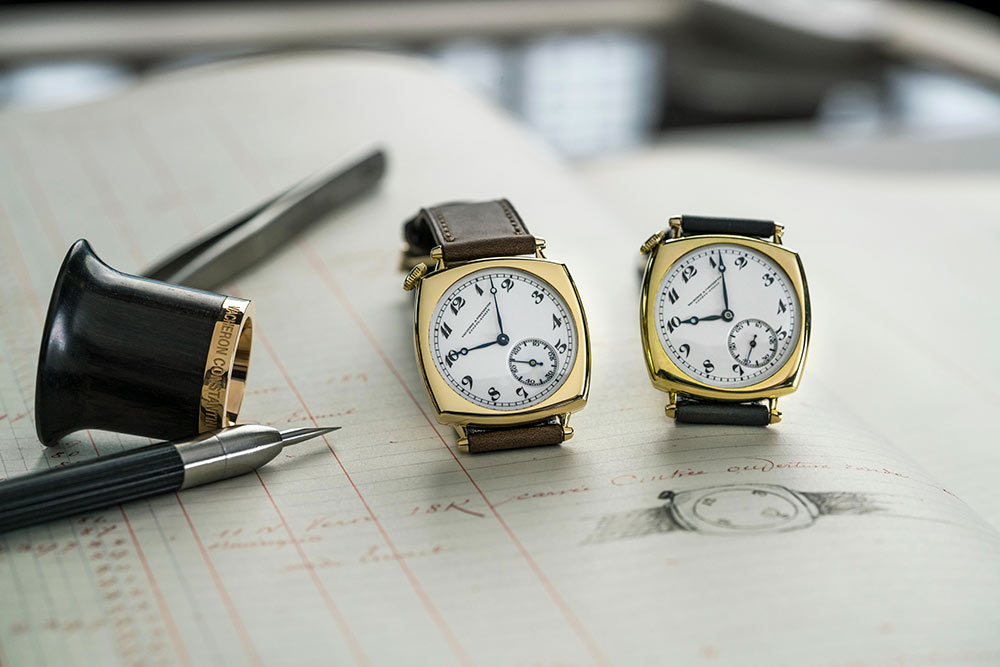
A dial and case distinguished by sophisticated craftsmanship
Accurately reproducing the exterior of the American 1921 also represented a real feat of manual workmanship. Here again, Vacheron Constantin’s watchmakers had to provide answers to numerous technical questions by observing the 1921 timepiece in minute detail, while comparing it with archive documents, and then individually crafting each element of the case and dial.
Some period components were available in the stocks of the Restoration workshop, such as rough blanks of the crown and hands. Others had to be entirely recreated, starting with the 31.5 mm case, according to the dimensions of the original American 1921. It was crafted by a Restoration workshop goldsmith from the specific gold alloy used for the historical model (18K 3N yellow gold), identified with the help of a spectrometer in order to reproduce its exact colour. Only a laser engraving applied to the case back, for customs purposes, distinguishes the American 1921 Pièce unique watch from its ancestor.
The creation of the dial also called for highly specialised expertise on the part of the artisan responsible for restoring the grain and unique beauty of the original dial. Crafted in Grand Feu enamel, an ancestral technique considered to be one of the most delicate in the field of watchmaking ornamentation, it required numerous firings in the kiln at a temperature of over 800°C. It features vintage numerals and logo, along with slender open-tipped hands that have been hand-blued by the Restoration workshop using the production techniques of the time.
And since no detail is left to chance, the exercise in style has continued right the way through to the end of the strap, whose pin buckle in 18K 3N yellow gold (the same alloy as the original model) was also produced in the Vacheron Constantin workshop.
A tribute to the art of wearing a watch in 1921
Because it retains all the original properties of the original American 1921, this unique, identically recreated timepiece reflects a historian’s approach.
It subtly mirrors the social and cultural context of the 1920s, the effervescence and the wind of freedom blowing across the United States and Europe at the dawn of the Roaring Twenties. Its distinctive design illustrates the stylistic creativity of Vacheron Constantin which revelled in expressing its “classic with a twist” style through multiple case shapes.
It also tells the story of the early days when the wristwatch began to become more widespread. At that time, men’s wristwatches were only just beginning to take precedence over pocket watches, until then regarded as more robust and accurate. Despite the considerable progress made by watch manufacturers in terms of movements’ resistance, reliability and miniaturisation, water-resistance requirements as we understand them today were not yet a reality. Choosing to wear time on the wrist thus meant exposing the watch to more risks in terms of shocks and external aggressions such as dust, humidity or water. In order to avoid any possible damage, watch owners took numerous precautions, notably including placing their wristwatch on the edge of the washbasin when they washed their hands. The watch was regarded as a life companion that was taken care of and had to be wound every day by hand.
————————————————————————
Sum-up
Enriched by a heritage based on the transmission of watchmaking expertise and stylistic research through generations of master artisans, Vacheron Constantin continues to celebrate the 100th anniversary of the American 1921 by recreating this emblematic model from scratch. From the 11-ligne Calibre Nouveau to the gold case along with the decorations and exterior components, the American 1921 Pièce unique watch reproduces the original properties of its ancestor created a century ago. This highly complex and unprecedented process involved the most experienced watchmakers in the Restoration workshop and the Vacheron Constantin Heritage team, who spent a year reviving old tools and forgotten know-how in the course of a passionately exciting human and technical adventure. The result is an exceptional one-of-a-kind timepiece, a symbol of the Maison’s attachment to its heritage and to the continuous enrichment of traditional know-how.

TECHNICAL DATA
American 1921 Pièce unique
Reference 1921H/000J-B949
Calibre
1921
Developed and crafted by Vacheron Constantin Mechanical, manual-winding
24.8 mm (11‘’’) diameter, 4.31 mm thick
Approximately 30 hours of power reserve
2.5 Hz (18,000 vibrations/hour)
115 components
16 jewels
Indications
Hours, minutes
Small seconds
Case
18K 3N yellow gold, same alloy as the 1921 original timepiece
Hand-crafted in the Vacheron Constantin restoration workshop
31 mm in diameter, 8.75 mm thick
Dial
White, Grand Feu enamel
Blued steel open-tipped hands – blued in our workshops
Strap
Brown calf leather, hand-sewn, tone-to-tone stitching, Calf lining
Buckle
18K 3N yellow gold pin buckle, same alloy as the 1921 original timepiece
Hand-crafted in the Vacheron Constantin restoration workshop







